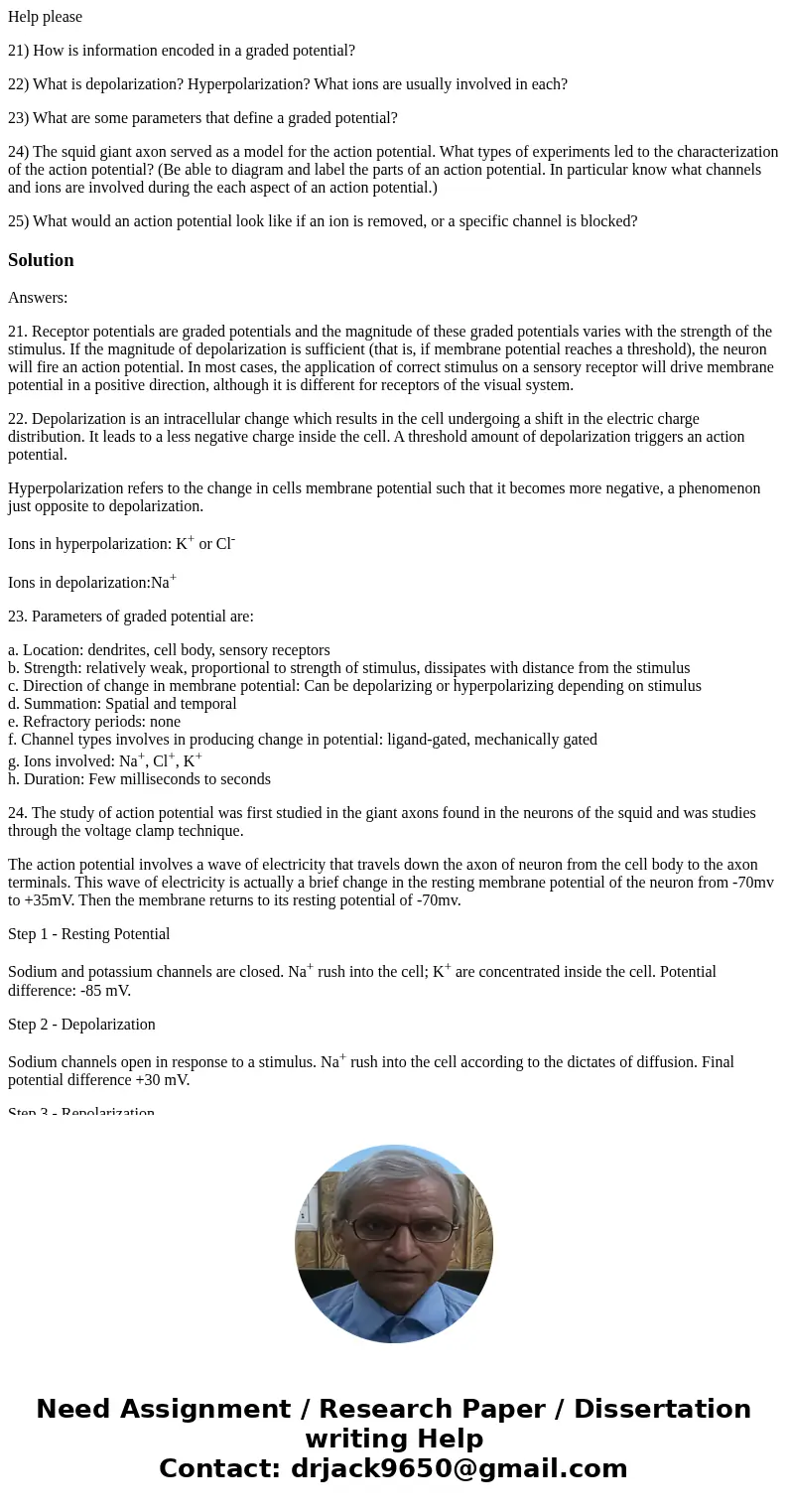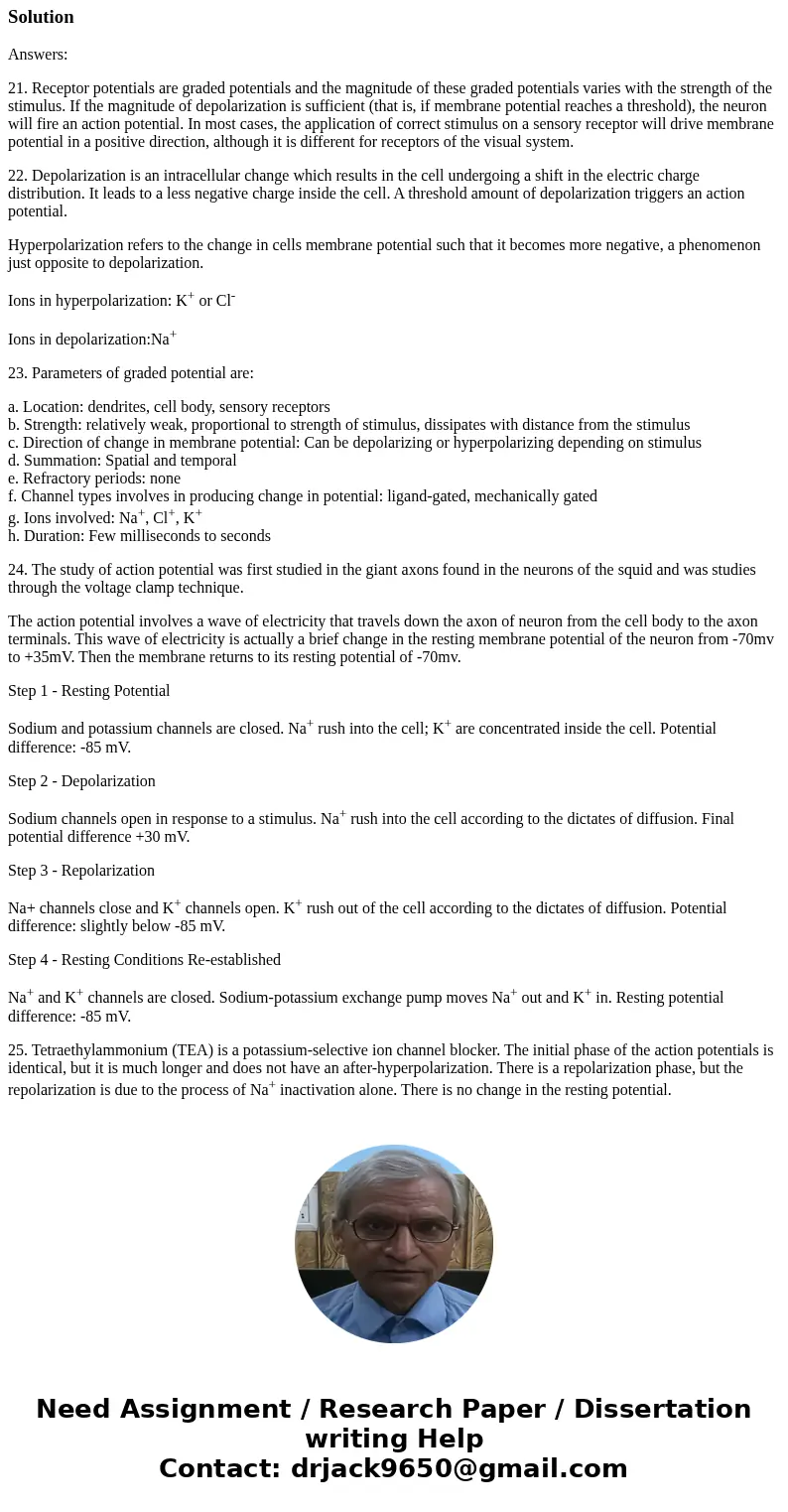Help please 21 How is information encoded in a graded potent
Help please
21) How is information encoded in a graded potential?
22) What is depolarization? Hyperpolarization? What ions are usually involved in each?
23) What are some parameters that define a graded potential?
24) The squid giant axon served as a model for the action potential. What types of experiments led to the characterization of the action potential? (Be able to diagram and label the parts of an action potential. In particular know what channels and ions are involved during the each aspect of an action potential.)
25) What would an action potential look like if an ion is removed, or a specific channel is blocked?
Solution
Answers:
21. Receptor potentials are graded potentials and the magnitude of these graded potentials varies with the strength of the stimulus. If the magnitude of depolarization is sufficient (that is, if membrane potential reaches a threshold), the neuron will fire an action potential. In most cases, the application of correct stimulus on a sensory receptor will drive membrane potential in a positive direction, although it is different for receptors of the visual system.
22. Depolarization is an intracellular change which results in the cell undergoing a shift in the electric charge distribution. It leads to a less negative charge inside the cell. A threshold amount of depolarization triggers an action potential.
Hyperpolarization refers to the change in cells membrane potential such that it becomes more negative, a phenomenon just opposite to depolarization.
Ions in hyperpolarization: K+ or Cl-
Ions in depolarization:Na+
23. Parameters of graded potential are:
a. Location: dendrites, cell body, sensory receptors
b. Strength: relatively weak, proportional to strength of stimulus, dissipates with distance from the stimulus
c. Direction of change in membrane potential: Can be depolarizing or hyperpolarizing depending on stimulus
d. Summation: Spatial and temporal
e. Refractory periods: none
f. Channel types involves in producing change in potential: ligand-gated, mechanically gated
g. Ions involved: Na+, Cl+, K+
h. Duration: Few milliseconds to seconds
24. The study of action potential was first studied in the giant axons found in the neurons of the squid and was studies through the voltage clamp technique.
The action potential involves a wave of electricity that travels down the axon of neuron from the cell body to the axon terminals. This wave of electricity is actually a brief change in the resting membrane potential of the neuron from -70mv to +35mV. Then the membrane returns to its resting potential of -70mv.
Step 1 - Resting Potential
Sodium and potassium channels are closed. Na+ rush into the cell; K+ are concentrated inside the cell. Potential difference: -85 mV.
Step 2 - Depolarization
Sodium channels open in response to a stimulus. Na+ rush into the cell according to the dictates of diffusion. Final potential difference +30 mV.
Step 3 - Repolarization
Na+ channels close and K+ channels open. K+ rush out of the cell according to the dictates of diffusion. Potential difference: slightly below -85 mV.
Step 4 - Resting Conditions Re-established
Na+ and K+ channels are closed. Sodium-potassium exchange pump moves Na+ out and K+ in. Resting potential difference: -85 mV.
25. Tetraethylammonium (TEA) is a potassium-selective ion channel blocker. The initial phase of the action potentials is identical, but it is much longer and does not have an after-hyperpolarization. There is a repolarization phase, but the repolarization is due to the process of Na+ inactivation alone. There is no change in the resting potential.


 Homework Sourse
Homework Sourse